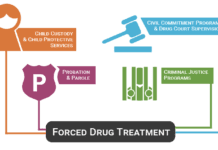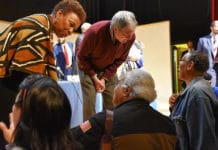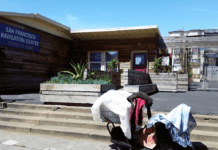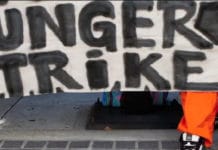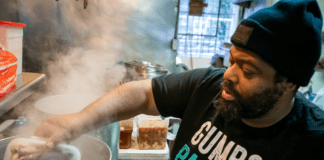by Sam Moore

The Board of Supervisor’s Public Safety Committee held a hearing on Thursday, April 11, in support of California State Assembly Bill 362, which would authorize a three-year pilot program allowing San Francisco to open overdose prevention sites where injection drug users could safely use pre-obtained drugs and access recovery services.
A similar bill, also authored by Sen. Susan Talamantes Eggman, D-Stockton, and co-authored by Sen. Scott Wiener, D-San Francisco, was vetoed by Gov. Jerry Brown in October. In his veto statement, Brown wrote that “enabling illegal and destructive drug use will never work” and that “the disadvantages of this bill far outweigh the possible benefits.” The idea was reintroduced as AB 362 in February.
“I was very disappointed in Jerry Brown for not passing it,” said Caycee Cullen, who has worked with people who inject drugs in an outreach capacity for over 20 years. “I expected more from him and felt like he was uninformed. (Overdose prevention sites) do not promote drug use – they help people make safe decisions and access the care or services they need.”
Laura Thomas, deputy state director for the Drug Policy Alliance, echoed these sentiments at Thursday’s hearing. She noted that the war on drugs first started in San Francisco, when the Board of Supervisors passed laws in the 1870s that made it illegal to smoke opium.
“This was the first use of criminalizing a substance as a way of xenophobic racial control,” she said. “It was targeting the Chinese community, who were smoking opium. It never made illegal the taking of opium pills, which could be purchased at a pharmacy.”
San Francisco’s racialized criminalization of drug use is still in full effect. According to a fact sheetpublished by the Center on Juvenile and Criminal Justice in 2018, Black people in San Francisco are disproportionately arrested on drug-related charges, even amid a sharp decline in the city’s drug arrests since 2015.
The fact sheet states that in 2016, Black San Franciscans experienced felony drug arrest rates 10 times higher than other races.
If passed, AB 362 would decriminalize all drug use inside overdose prevention sites. The sites would also provide drug users with referrals to medical treatments and recovery programs which previously would have been inaccessible to marginalized groups.
“There’s not enough drug treatment in this city currently,” said Amber Sheldon, an employee at GLIDE in the Tenderloin, during the hearing’s public comment portion. “All the time, I have people coming in and asking me to help get them into treatment. They have to wait weeks or months and jump through many hoops in order to get into these treatments. The easiest way to get into drug treatment in San Francisco is to get incarcerated.”
“This was the first use of criminalizing a substance as a way of xenophobic racial control”
Caycee Cullen’s career involves working with drug users who have been diagnosed with the Hepatitis-C virus, many of whom are members of vulnerable communities that don’t have access to consistent medical care. After being diagnosed, Cullen said, most of these people don’t seek any treatment at all.
Several speakers noted throughout the hearing that in the over 100 safe injection sites currently operating around the world, there has never been an instance of Hep-C or HIV contraction. There has also never been an overdose death.
“Now is the time for us to be a leader and take the first steps in starting a clean injection site,” said community member Andre Edwards. “If you don’t, things the doctors can’t even explain will continue to happen to people like me.”
“I’ve had to hurry up and do a shot because the police were coming or a kid was coming down the sidewalk,” said Robert Greer, a volunteer at the San Francisco Drug Users’ Union. “You get an abscess because you miss – I’m going through that right now with my arm.”
Department of Public Health employee Eileen Loughran said during a presentation she gave at the hearing that one 13-booth injection site would save the city an estimated $3.5 million, as a result of fewer ambulance rides, ER visits, Hep-C and HIV infections, bacterial infections and overdoses. According to a poll conducted by the San Francisco Chamber of Commerce, 77 percent of San Franciscans polled were in support of AB 362.
Despite this, several people at the hearing voiced opposition to the bill.
“We should use our money to encourage healthy lifestyles,” said Wendy Wong, a member of the San Francisco Coalition for Good Neighborhoods. “It is a waste of our money to be put into safe injection sites. No drug abuse is safe, no matter how you see it.”
Others expressed concerns that overdose prevention sites might have a negative effect on children or encourage people to start using drugs. Supervisor Catherine Stefani addressed these concerns at the end of the hearing.
Earlier, she spoke of her brother’s struggle with heroin addiction.
“I get the fear,” she said, “and what I would encourage people to do is come to this issue from a place of love and compassion, and really try to understand what addicts and alcoholics are going through. And that is such an incredibly hard thing to ask you to do if you have no idea what that means.”
“The truth is that I wasn’t ready for treatment,” said Curtis Bradford, a board member of the Tenderloin Community Benefit District, of his experience with harm reduction services. “I didn’t ask for treatment – but they kept caring for me until I was ready.
“Thank God we had these services that kept me alive long enough to make that decision. That’s what this is about.”
Sam Moore, a San Francisco State University journalism student, is an intern with the Bay View. He can be reached at samoore2015@gmail.com.

 Store
Store



